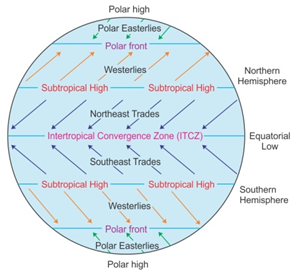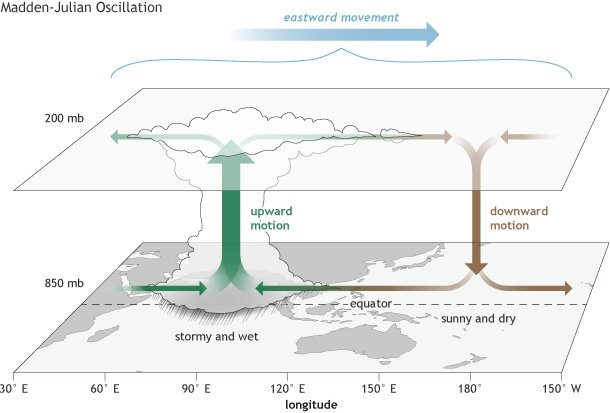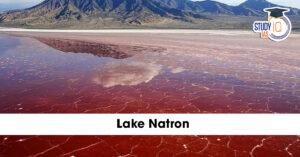Table of Contents
Context: Early onset of monsoon happened due to a range of different reasons, including the active phase of the Madden-Julian Oscillation (MJO) and a low-pressure system etc.
Pressure System of Earth
What is a Pressure System?
- A pressure system is a region on Earth’s surface where the atmospheric pressure is either higher or lower than the surrounding areas. These differences in pressure drive wind and weather patterns across the globe.

Types of Pressure Systems
- High Pressure System (Anticyclone): An Area where atmospheric pressure is higher than in surrounding areas.
- Characteristics:
- Air descends (subsides), leading to compression and warming.
- Results in clear skies and stable weather.
- Winds flow outward and clockwise in the Northern Hemisphere, anti-clockwise in the Southern Hemisphere.
- Low Pressure System (Cyclone): An Area where atmospheric pressure is lower than in surrounding areas.
- Characteristics:
- Air rises, cools, and condenses, often forming clouds and precipitation.
- Associated with unstable weather: clouds, rain, or storms.
- Winds flow inward and counterclockwise in the Northern Hemisphere, clockwise in the Southern Hemisphere.
- Characteristics:
- Significance:
- Drives global wind systems like the Trade Winds, Westerlies, and Polar Easterlies.
- Influences weather patterns, ocean currents, and climate zones.
| Major Global Pressure Belts |
|
Madden-Julian Oscillation (MJO)
What is MJO? It is a large-scale movement of clouds, rainfall, winds, and pressure that travels eastward around the tropical belt of the Earth, mainly over the Indian and Pacific Oceans.
Key Features
- Time Scale: Typically recurs every 30–60 days.
- Movement: Travels eastward at 4–8 m/s.
- Structure: Comprises two phases:
- Active (Convective) Phase: Increased convection, cloudiness, and rainfall.
- Suppressed (Dry) Phase: Decreased convection, less cloudiness, and reduced rainfall.

Mechanism
- Initiation: Begins in the western Indian Ocean.
- Propagation: Moves eastwards across the tropics, affecting weather in Africa, the Indian Ocean, Southeast Asia, the Pacific Ocean, and sometimes even the Americas.
- Interaction: Influences monsoons, cyclones, and global weather patterns by modulating the atmospheric circulation.
Impact on Indian Weather
- Monsoon: A strong MJO can enhance or suppress the Indian monsoon rains depending on its phase and position.
- Cyclones: Can increase the likelihood of cyclone formation in the Indian Ocean.
Significance
- Influences El Niño and La Niña events (ENSO).
- Affects weather and rainfall patterns worldwide, including hurricanes and droughts in distant regions.


 Places in News for UPSC 2026 for Prelims...
Places in News for UPSC 2026 for Prelims...
 Lake Natron: Location, Features, Wildlif...
Lake Natron: Location, Features, Wildlif...
 Erra Matti Dibbalu Added to UNESCO Tenta...
Erra Matti Dibbalu Added to UNESCO Tenta...

























